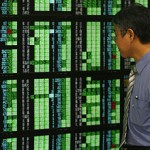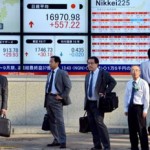Asian stocks advance on China rate cut, U.S. tech earnings

Asian stocks on Monday were close to wiping out all their losses since China’s shock currency devaluation in August, as global equities rallied after the Chinese central bank cut rates and U.S. tech giants provided upbeat earning guidance.
MSCI’s index of Asia-Pacific shares outside Japan .MIAPJ0000PUS rose 0.5 percent to hit its highest since Aug. 12, led by 1.2 percent gains in Honk Kong .HSI. Japan’s Nikkei .N225 rose 1.1 percent to a two-month high.
The surprise move by China lifted risk assets that had been already boosted by Thursday’s message from the European Central Bank that it stood ready to enhance quantitative easing and cut interest rates to even deeper negative levels.
“These moves by the ECB and China are raising speculation that the Bank of Japan will act later on this week as well,” Masahiro Ichikawa, senior strategist at Sumitomo Mitsui Asset Management. The BOJ will hold its next policy review on Friday.
The U.S. Federal Reserve is also widely expected to refrain from raising rates at its two-day policy meeting on Tuesday and Wednesday.
Against these backdrop, the MSCI’s index of the world’s share markets .MIWD00000PUS shot up to its highest level since Aug. 20, having risen more than 10 percent from its two-year low hit less than a month ago.
It has recovered most of the losses since Aug. 11, when China’s sudden devaluation of the yuan sparked worries its economy may be in deeper trouble than many had thought.
On Wall Street, S&P 500 Index .SPX rose 1.1 percent to turn positive on the year, while the tech-heavy Nasdaq jumped 2.3 percent .IXIC.
Technology shares led the way, thanks to gains in Alphabet (GOOGL.O), Amazon (AMZN.O) and Microsoft (MSFT.O), after the three companies reported earnings results. The former two hit record highs, while Microsoft rose to a 15-year high.
Mainland Chinese shares rose on Monday after China cut the benchmark one-year lending rate – for the sixth time in less than a year – by 25 basis points to 4.35 percent, and lowered big banks’ reserve requirement ratio late.
Gains were fairly limited, however, with Shanghai composite index .SSEC up just 0.5 percent.
Naoki Tashiro, the president of TS China Research, noted that in the week following each of the past year’s five rate mainland shares rose three times but fell twice.
“Mainland investors are cautious. The market has been rallying so far this month, so some investors could may well take profits into rally,” he said.
One big focus is Chinese Communist party’s central committee meeting from Monday to Thursday to set out a new five-year plan, while investors attempt to gauge how much China’s growth is likely to slow in coming years.
Ahead of the central committee meeting, Premier Li Keqiang said that China has never stated the economy must grow seven percent this year, coinciding with remarks by a top central bank official on Saturday that China would be able to keep annual economic growth at around 6-7 percent over that period.
Risk sentiment supported by Thursday’s message from European Central Bank President Mario Draghi that the bank stood ready to enhance quantitative easing.
That saw the Italian IT2YT=TWEB and Spanish ES2YT=TWEB two-year government bond yields both turn negative for the first time, meaning investors effectively pay to hold them.
The benchmark German two-year yield fell further to minus 0.345 percent DE2YT=TWEB.
As negative yields undermine the attraction of holding the euro, traders pushed it to a 2 1/2-month low of $1.0989 EUR= in early Asian trade. It last stood at $1.1031, bouncing back on profit-taking.
The yen dipped to 121.60 to the dollar JPY=, its lowest since late August as traders speculated the Bank of Japan might unleash additional easing on Friday, before bouncing back to 121.16 on profit-taking,
“The Japanese economy is weaker than in August and there’s no sign of a rebound. Markets are now expecting easing from the BOJ,” said Takeru Ogihara, chief strategist at Mizuho Trust Bank.
Despite a recovery in global equity prices, oil prices were softer, pressured by ongoing oversupply worries.
U.S. crude futures CLc1 stood at $44.68, hardly recovering after a fall of 5.6 percent last week, not far from three-week low of $44.20 touched on Friday.
Source: Reuters – Asian stocks advance on China rate cut, U.S. tech earnings




























